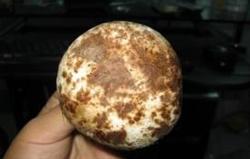The polluted material of Pleurotus ostreatus can be replanted.

In the cultivation of Pleurotus ostreatus, the culture material is often scrapped by miscellaneous bacteria infection after inoculation because of serious environmental pollution, lax disinfection of mushroom room, careless operation process, aging of bacteria and so on. In order not to waste raw materials, the contaminated materials can be treated by the following two methods: 1. The pasteurization method uses 6000kg 7000g of lime and 400kg 500g of carbendazim for every 100 kg of contaminated material, and adjusts the contaminated material to 65% water content. After mixing well, pile the material as high as possible, use a 4cm thick stick to drill a hole vertically to the bottom of the pile, drill a hole every 30cm to 40cm, and rotate to pull it out. After beating, the fermentation was covered with film, and the pile was turned when the temperature of the material rose to 60-70 ℃. After resuming the heap, turn the heap twice according to the previous method, then cool down the heap in bulk, and connect the viable bacteria with a seed dosage of about 15%. two。 By atmospheric pressure sterilization, the contaminated materials were dried in the sun and raked with a rake for a total of 2 to 3 days. According to 100kg of contaminated material, 3000 grams of lime and 300g of carbendazim, the water content was adjusted to about 60%. After bagging, it was sterilized under atmospheric pressure for 10 hours, then stuffed for 12 hours, and then cold to room temperature. After inoculation, the temperature of the culture room was kept at 15-20 ℃, the mycelium could develop normally, the bag could be full in about 35 days, the mushroom bud appeared in 40 days, and the mushrooms could be harvested in 4-5 days. The development time is 5-7 days later than the normal material, 2-3 tide mushrooms can be harvested, and the biological efficiency is 70-80%.
- Prev

Cultivation of Pleurotus ostreatus: strict control of seed production
The rust or dark brown spots on the cap and stalk of Pleurotus ostreatus are called Pleurotus ostreatus rust spot. This disease is a kind of bacterial disease which is easy to occur in the growth stage of Pleurotus ostreatus fruit body. The pathogen causing the disease is Pseudomonas aeruginosa, which is widely distributed in nature. At the beginning of the disease, the disease spot is only needle-like size, color.
- Next

Flood potassium fertilizer loss, crop potassium supplement is indispensable
In previous years, potassium deficiency symptoms of cotton, rice, corn, soybean, peanut and other crops were generally seen in several provinces in the middle and lower reaches of the Yangtze River. In addition to potassium deficiency in some soils themselves, it was largely related to the heavy rainfall and potassium loss during crop growth this year. From the cotton point of view, most cotton fields are short of...
Related
- Fuxing push coffee new agricultural production and marketing class: lack of small-scale processing plants
- Jujube rice field leisure farm deep ploughing Yilan for five years to create a space for organic food and play
- Nongyu Farm-A trial of organic papaya for brave women with advanced technology
- Four points for attention in the prevention and control of diseases and insect pests of edible fungi
- How to add nutrient solution to Edible Fungi
- Is there any good way to control edible fungus mites?
- Open Inoculation Technology of Edible Fungi
- Is there any clever way to use fertilizer for edible fungus in winter?
- What agents are used to kill the pathogens of edible fungi in the mushroom shed?
- Rapid drying of Edible Fungi

